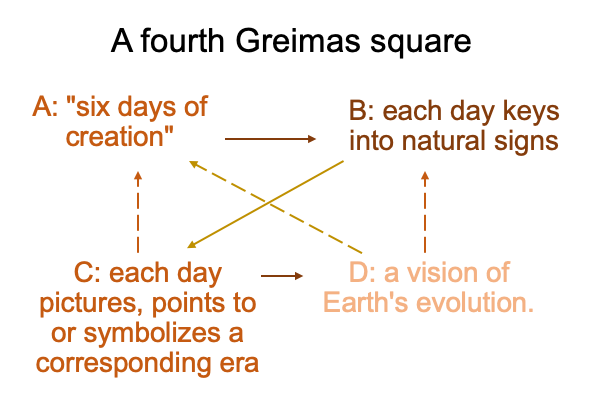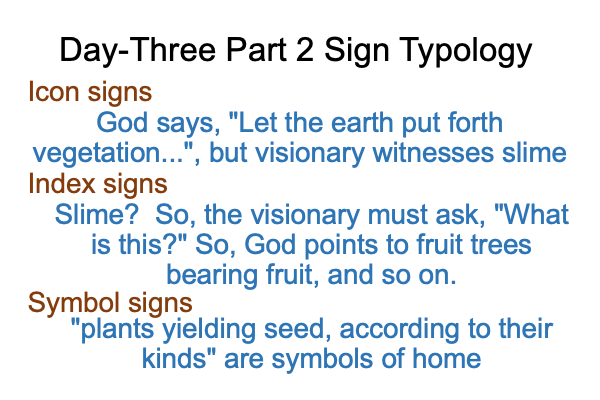0036 Of course, none of this sign business shows up in Loke’s chapter three, concerning the time span of creation, or chapter four, concerning the process of evolutionary creationism.
Nonetheless, the sign business is relevant because we are moving upstream from the falls along the metaphorical Nile. Yes, this is the one on the map that we altered with a pencil.
0037 We regard the seven days of creation (A), while looking though abstractions that are typical of our current Lebenswelt (B). In doing so, we cross a epistemological boundary between scripture and science (C), which must imply that a conversation may take place. But, can a conversation proceed if one of the conversants says that each Genesis day is literally true and is composed of what we current label a “day”? Yes, if the Creation Story is a sequence of visions (D).
0038 Here is a picture of the corresponding Greimas square.

0039 The focus is the first Genesis Creation Story (A, sign-vehicle).
The contrast is the idea that each day keys into Peirce’s typology of natural signs (B, sign-interpretant).
The actual correspondences (C) speak against the idea (B), just as any application of an idea speaks against the idea. Since when are ideas perfectly applied?
0040 For example, the end of day three associates with the earliest photosynthetic life, which looks like slime. Yes, mats of green or red or purple slime, bearing according to their slimes. So, the visionary must be a little perplexed.
In day three, the Genesis text breaks the previous pattern, by mentioning two creations in one day. The associations are to the formation of the earliest continents and to the earliest appearance of life on Earth, which includes photosynthetic bacteria, which form colorful mats on most anything wet. In fact, the slime looks like anything but fruit trees bearing fruit and plants bearing seed. These bacteria do not have chloroplasts, the photosynthetic organelle in almost all multicellular plants. They are the precursors to chloroplasts.
0041 Consequently, the application of the idea of sign typology requires some interpretive flexibility.

0042 But, that does not mean that the interpretant of sign-typology does not work. Rather, the idea seems even more promising, because the vision (D) is necessarily mind-boggling.
0043 Consider three titles.
The Creation Story and Evolution
Genesis One As A Sign of the Evolutionary Record
The Creation of Man and Human Evolution
These titles are over twenty years old.
Yet, they are as fresh as the dawn of a new Age of Understanding.
